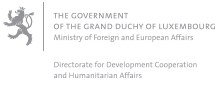- Home
- Preface
- I. Luxembourg’s Official Development Assistance in 2012
- DAC peer review
- On the path to 2015
- II. Cooperation with partner countries
- III. Regional cooperation and cooperation with other countries
- IV. Multilateral cooperation
- V. Cooperation with non-governmental organisations
- VI. Humanitarian aid
- VII. Programme support
- VIII. Awareness-raising and development education
- IX. Microfinance
- X. Evaluation
- XI. Progress report on the Inter-ministerial Committee for Development Cooperation
- Appendices
VI. Humanitarian aid

emergency.lu in South Sudan

Ambulances donated to Jordan
Prevention
Prevention constitutes the third pillar of Luxembourg’s humanitarian aid strategy and is relevant both prior to, and after, the emergency aid and transition phases. Luxembourg’s humanitarian aid strategy commits to devote at least 5 % of the annual humanitarian aid budget to funding prevention activities.
Investing in disaster risk reduction and resilience is cost effective: reducing risks is generally less expensive than providing emergency aid; rehabilitation/reconstruction work often remains costly for several years after the disaster. Reducing the impact and addressing the causes of recurrent crises, rather than simply responding to disasters, is not only in the best interest of the populations concerned but also cheaper and more sustainable.
The ministry therefore funded disaster risk reduction projects implemented by the Caritas Foundation Luxembourg, the Luxembourg Red Cross, Handicap International Luxembourg and Care in Luxemburg. The ministry also supported the work of the United Nations Office for Disaster Risk Reduction (UNISDR), the United Nations Development Programme (UNDP-BCPR), and World Bank’s disaster reduction and recovery mechanism (Global Facility for Disaster Risk Reduction - GFDRR).
A total of 2 452 049 euros was allocated to “prevention” projects in 2012, representing 5.92 % of total humanitarian aid spending for the year.

